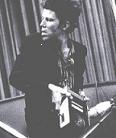Here's a calculator that can demonstrate the effect...you'll find it's much more prevalent at high frequencies.
http://www.sengpielaudio.com/calculator-air.htm
So we can simulate distance with a filter, when pulling the mic back and adding gain isn't practical.
There's part of me that's skeptical about such anecdotal evidence. I'd want to know more about the test protocol, and how the filtering was implemented and tested. Did they carefully verify that there were truly no changes in the 20 to 20,000 Hz range? Designing a filter that's a hard stop at 20 KHz is not a trivial matter...and one of the common side effects is that the frequency response of the passband becomes bumpy. (and audible) Is there any chance that the filtering process either changed the audible band somehow, or that there were other effects related to the wider bandwidth material (intermodulation distortion, perhaps?).My science of music professor, Mark Ballora, always cited a study that was done where they played a recording to test subjects that had all of its 20 kHz content in tact, and then they played the recording again with all of the 20+ kHz data cut off. The test subjects were able to identify which one had more data even though all of the sound was above the human hearing level.
If wider bandwidth source material were obviously superior, 96 or 192 KHz sampling would be a foregone conclusion, and we'd all have DVD-A or HDCD players by now.
Absolutely? None of them.which instruments do you think absolutely need that "air"
12 string guitar on Tuesdays.
Cymbals on Thursday evenings.
And more air on everything as a long night of mixing becomes even longer.
You might solo tracks through a spectrum analyzer. You'll find that there are lots of sources without much going on above 5 or 10 KHz.

